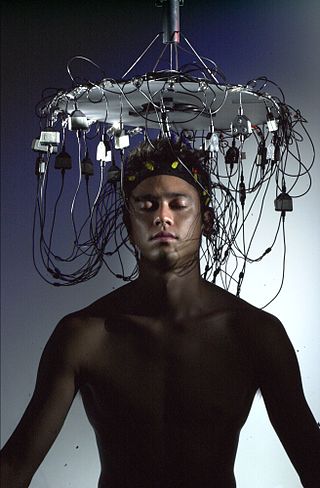Brain waves are rhythmic or repetitive neural activity in the central nervous system.
Brain wave or brainwave may also refer to:
Brain waves are rhythmic or repetitive neural activity in the central nervous system.
Brain wave or brainwave may also refer to:

Epilepsy is a group of non-communicable neurological disorders characterized by recurrent epileptic seizures. An epileptic seizure is the clinical manifestation of an abnormal, excessive, purposeless and synchronized electrical discharge in the brain cells called neurons. The International League Against Epilepsy has; in 2005 and again in 2014 published guidelines about the definition of epilepsy for operational purposes. In the past epilepsy was defined as 2 or more unprovoked seizures- with the understanding that this was an enduring condition that would repeat itself. The new definition includes the occurrence two or more seizures separated by 24 hours, or of a single seizure with a chance at recurrence after 2 seizures of greater than 60% in the next 10 years associated with the neurobiologic, cognitive, psychological and social repercussions of this condition( ILAE Fisher et al 2014, 2005) Epileptic seizures can vary from brief and nearly undetectable periods to long periods of vigorous shaking due to abnormal electrical activity in the brain. These episodes can result in physical injuries, either directly such as broken bones or through causing accidents. In epilepsy, seizures tend to recur and may have no immediate underlying cause. Isolated seizures that are provoked by a specific cause such as poisoning are not deemed to represent epilepsy. People with epilepsy may be treated differently in various areas of the world and experience varying degrees of social stigma due to the alarming nature of their symptoms.

An electroencephalophone or encephalophone is an experimental musical instrument and diagnostic tool which uses brain waves to generate or modulate sounds.

Delta waves are high amplitude neural oscillations with a frequency between 0.5 and 4 hertz. Delta waves, like other brain waves, can be recorded with electroencephalography (EEG) and are usually associated with the deep stage 3 of NREM sleep, also known as slow-wave sleep (SWS), and aid in characterizing the depth of sleep. Suppression of delta waves leads to inability of body rejuvenation, brain revitalization and poor sleep.
The Injustice Society is a group of supervillains in the DC Comics Universe. They are the main antagonists of the Justice Society of America.

A mind machine uses pulsing rhythmic sound, flashing light, or a combination of these to alter the frequency of the user's brainwaves. Mind machines can induce deep states of relaxation, concentration, and in some cases altered states of consciousness, which have been compared to those obtained from meditation and shamanic exploration. Photic mind machines work with flickering lights embedded in sunglasses or a lamp that sits above or facing the user's head. The user then "watches" with their eyes closed.
A gamma wave or gamma rhythm is a pattern of neural oscillation in humans with a frequency between 25 and 140 Hz, the 40 Hz point being of particular interest. Gamma rhythms are correlated with large scale brain network activity and cognitive phenomena such as working memory, attention, and perceptual grouping, and can be increased in amplitude via meditation or neurostimulation. Altered gamma activity has been observed in many mood and cognitive disorders such as Alzheimer's disease, epilepsy, and schizophrenia.
Alpha waves, or the alpha rhythm, are neural oscillations in the frequency range of 8–12 Hz likely originating from the synchronous and coherent electrical activity of thalamic pacemaker cells in humans. Historically, they are also called "Berger's waves" after Hans Berger, who first described them when he invented the EEG in 1924.
Brainwave entrainment, also referred to as brainwave synchronization or neural entrainment, refers to the observation that brainwaves will naturally synchronize to the rhythm of periodic external stimuli, such as flickering lights, speech, music, or tactile stimuli.
Focal seizures are seizures which affect initially only one hemisphere of the brain. The brain is divided into two hemispheres, each consisting of four lobes – the frontal, temporal, parietal and occipital lobes. A focal seizure is generated in and affects just one part of the brain – a whole hemisphere or part of a lobe. Symptoms will vary according to where the seizure occurs. When seizures occur in the frontal lobe the patient may experience a wave-like sensation in the head. When seizures occur in the temporal lobe, a feeling of déjà vu may be experienced. When seizures are localized to the parietal lobe, a numbness or tingling may occur. With seizures occurring in the occipital lobe, visual disturbances or hallucinations have been reported.

Brainwave or Brainwave Jr. is a character in the DC Comics Universe, who is commonly portrayed as a superhero and son of the supervillain, Brain Wave, along with primarily being a member of the Infinity, Inc.
Myoclonic epilepsy refers to a family of epilepsies that present with myoclonus. It starts in both sides of the body at once, and last for more than a second or two. When myoclonic jerks are occasionally associated with abnormal brain wave activity, it can be categorized as myoclonic seizure. If the abnormal brain wave activity is persistent and results from ongoing seizures, then a diagnosis of myoclonic epilepsy may be considered. Myoclonic seizures frequently occur in day-to-day life. During sleep, abrupt jerks and hiccups occurred.

Merry Pemberton, also known as Gimmick Girl and Merry, Girl of 1000 Gimmicks is a fictional character in the DC Comics Universe. She is the adoptive sister of Sylvester Pemberton. Merry Pemberton first appeared in Star-Spangled Comics #81 in June 1948, and ran through #90. She was created by writer Otto Binder.

Paul Crossan is an Irish radio personality. He was born in Drimnagh, Dublin 12, grew up in Crumlin, and attended Drimnagh Castle Secondary School and later UCD. He has been a presenter on RTÉ 2fm since 2001. O'Shea has also presented The Poetry Programme on RTÉ Radio 1 in 2015 and 2016. Since 2017 he has been presenting the morning show on RTÉ Gold. He is currently presenting The Book Show on RTÉ Radio 1 since 2019.
Flicker vertigo, sometimes called the Bucha effect, is "an imbalance in brain-cell activity caused by exposure to low-frequency flickering of a relatively bright light." It is a disorientation-, vertigo-, and nausea-inducing effect of a strobe light flashing at 1 Hz to 20 Hz, approximately the frequency of human brainwaves. The effects are similar to seizures caused by epilepsy, but are not restricted to people with histories of epilepsy.
Brainwaves is a single-panel cartoon series by Betsy Streeter. Brainwaves has been described as "a single-panel stream of consciousness about the infinite absurdity of everyday life."

Electroencephalography (EEG) is a method to record an electrogram of the spontaneous electrical activity of the brain. The biosignals detected by EEG have been shown to represent the postsynaptic potentials of pyramidal neurons in the neocortex and allocortex. It is typically non-invasive, with the EEG electrodes placed along the scalp using the International 10-20 system, or variations of it. Electrocorticography, involving surgical placement of electrodes, is sometimes called "intracranial EEG". Clinical interpretation of EEG recordings is most often performed by visual inspection of the tracing or quantitative EEG analysis.
The Force Trainer is a Star Wars-themed toy which creates the illusion of performing Force-powered telekinesis.
Mindflex is a toy by Mattel by which a child uses their brain waves to steer a ball through an obstacle course. Brain waves are registered by the enclosed EEG headset, which allows the child to control an air stream by concentrating, thus lifting or lowering a foam ball. The game was released in the fall of 2009, and uses the same microchip as the MindSet from NeuroSky and homebuilt EEG machines.
Epilepsy Ireland, known as Brainwave – The Irish Epilepsy Association prior to 7 February 2013, is a charity in Ireland who, among a wide variety of objectives, provide support, information and advice to people with epilepsy. They were founded in 1966, and are based in Dublin, with nine regional offices throughout Ireland.
Brain Wave is a supervillain appearing in the DC Comics Universe, a recurring foe of the Justice Society of America and a founding member of the Injustice Society; he is also the father of the superhero Brainwave.